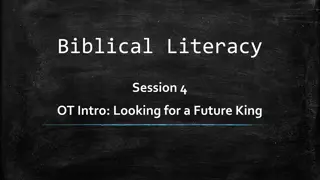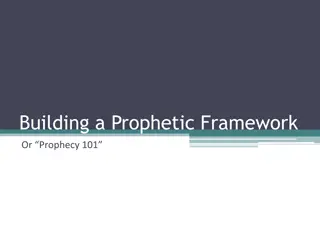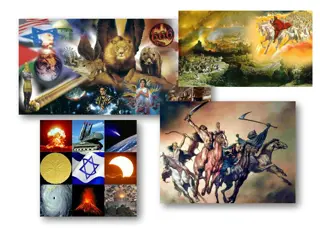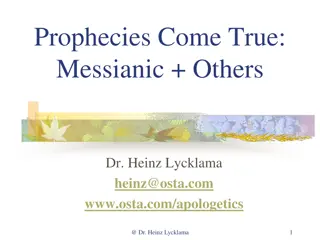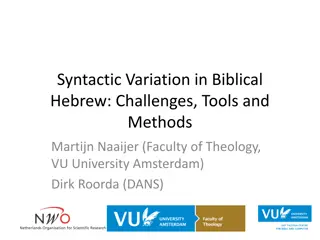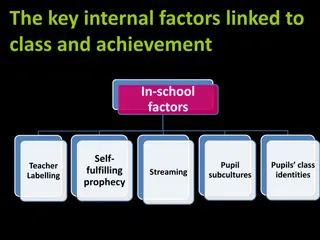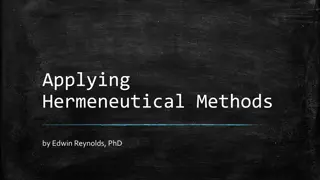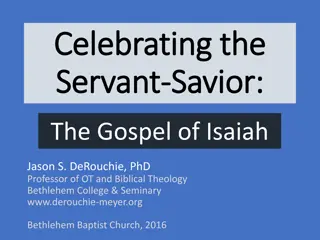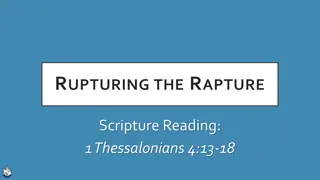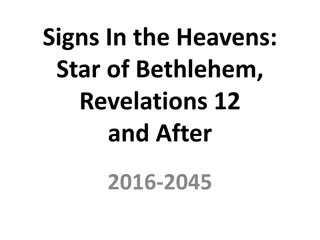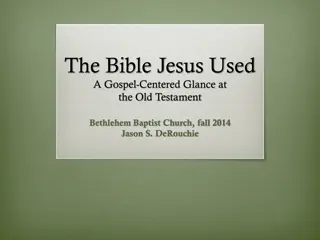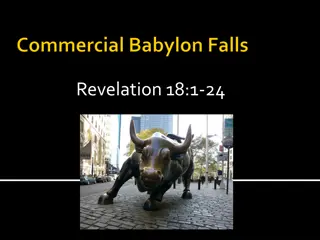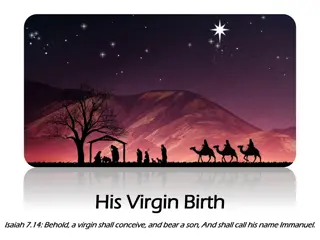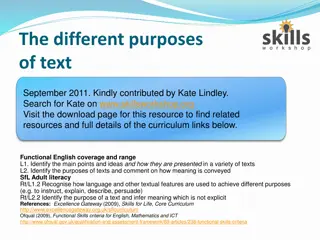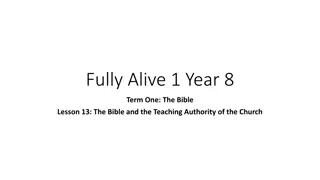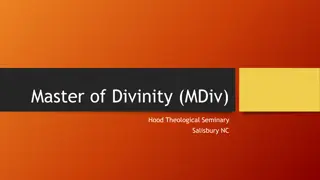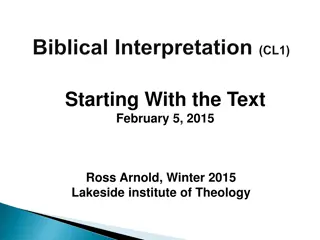Understanding Prophecy in Biblical Texts
Exploring the nature of prophecy in the Old Testament, this chapter delves into subgenres, major and minor prophets, and the significance of prophetic messages. It highlights the dual themes of judgment and salvation, while emphasizing the hope of restoration even in the face of divine judgment.
Download Presentation

Please find below an Image/Link to download the presentation.
The content on the website is provided AS IS for your information and personal use only. It may not be sold, licensed, or shared on other websites without obtaining consent from the author. Download presentation by click this link. If you encounter any issues during the download, it is possible that the publisher has removed the file from their server.
E N D
Presentation Transcript
Chapter 7 BACK TO THE FUTURE: PROPHECY
CHAPTER OUTLINE The Nature of Prophecy Subgenres of Prophecy Prophecy Outside of the Old Testament Prophetic Books Sample Exegesis: Nahum
THE NATURE OF PROPHECY Four major prophets: Isaiah, Jeremiah/Lamentations, Ezekiel, and Daniel Twelve so-called Minor Prophets : Hosea, Joel, Amos, Obadiah, Jonah, Micah, Nahum, Habakkuk, Zephaniah, Haggai, Zechariah, and Malachi. Though difficult to interpret, the realization that these prophets were real people sent by God to people in a real (albeit ancient) world gives us assurance that understanding their messages is a realizable goal.
SUBGENRES OF PROPHECY Our identification of what we take to be the genre to which a particular text belongs raises certain expectations about how the contents of the writing are to be understood (p. 342, citing Cotterell and Turner). The two most prominent subgenres of prophecy are those dealing with judgment and salvation.
SUBGENRES OF PROPHECY Instructional Accounts Disputations Exhortation/Warning Speeches Satire Wisdom Sayings Prophetic Narratives Miscellaneous Subgenres Vision/Dream Report Prophetic Hymns/Songs Prophetic Prayers Prophetic Letters
SUBGENRES OF PROPHECY Announcements of Judgment General Characteristics Accusation Announcement of a specific judgment May include a call to hear the announcement Prophetic messages can be boiled down to three basic points, each of which is important to the message of the prophets: You have broken the covenant; you had better repent! No repentance? Then judgment! Yet, there is hope beyond the judgment for a glorious, future restoration.
SUBGENRES OF PROPHECY Announcements of Judgment Woe Oracle Invective (pronouncement of woe) Threat (details of coming judgment) Criticism (the reason for the coming judgment) Example: Habakkuk 2:6 20 Lament Lament involves prayer to God and a statement of distress or mourning. Laments can also be found in the Psalms and wisdom literature. Example: Amos 5:1 17 Example: Ezekiel 19
SUBGENRES OF PROPHECY Announcements of judgment Covenant Lawsuit God summons his people to appear before him for covenant violations. These announcements usually contain: Summoning of witnesses List of charges against the accused Announcement of punishment Example: Micah 6:1 6
SUBGENRES OF PROPHECY Salvation Oracles The Promise of Deliverance Salvation prophecies customarily deal with God s deliverance after a time of experiencing his judgment. Frequently, you will detect a pattern of sin, judgment, repentance, and restoration. Particularly prominent is the exodus motif. Kingdom Oracles Deal with the establishment of Israel s final kingdom. Also contain an announcement of universal judgment, often in a series of judgments. The last judgment completes the series and serves to prepare for the final era of blessing. Example: Joel 3:9 21
SUBGENRES OF PROPHECY Salvation Oracles (cont d) Apocalyptic Definition: a genre of revelatory literature with a narrative framework, in which a revelation is mediated by an otherworldly being to a human percipient, disclosing a transcendent reality which is both temporal insofar as it envisages eschatological salvation, and spatial insofar as it involves another, supernatural world.
SUBGENRES OF PROPHECY Salvation Oracles (cont d) Apocalyptic Features: This present world is evil and without hope, and can be remedied only by sovereign divine intervention. The issue of the ages is essentially a spiritual battle between good and evil. The Lord s intervention will entail catastrophic events. Following the time of God s universal judgment, a final new age of peace, prosperity, and righteousness will be ushered in. Apocalyptic literature customarily is presented via visions of the future and contains graphic images, fantastic other- worldly settings and scenes, and an abundant use of symbols, such as the use of numbers, colors, and animals.
SUBGENRES OF PROPHECY Salvation Oracles (cont d) Apocalyptic Examples from the OT include Isaiah 24 27; Ezekiel 38 39; Daniel 7; Joel 2:28 32; 3:9 17, and Zechariah 1 6; 12 14. Full blown apocalypses, however, do not occur until after the OT era. Prophecy appears to have gradually merged into apocalyptic. Most of the essential features of the kind of apocalyptic literature which flourished from 200 B. C. to A. D. 100 have roots in the prophetic literature of the sixth and fifth centuries B.C. Apocalyptic is therefore an inner- Jewish development (David Aune, Prophecy in Early Christianity and the Mediterranean World, 112).
SUBGENRES OF PROPHECY Guidelines for interpreting apocalyptic Acquaint yourself with the characteristics of apocalyptic Note the setting of the passage both in its historical dimension and contextual orientation. Distinguish carefully the use of symbols, themes, and figures of speech from their standard literal sense. Determine the author s purpose in using apocalyptic features. As with other types of prophecy, try to place yourself in the oral setting of those who first heard the message. 1. 2. 3. 4. 5.
SUBGENRES OF PROPHECY Guidelines for apocalyptic (cont d) In teaching or preaching the passage to others, be sure to emphasize the spiritual content resident in its message, particularly in the ultimate resolution of divine teleology it presents. Above all, make the application of the passage relevant to the lives of those whom you are attempting to reach. 1. 2.
SUBGENRES OF PROPHECY Instructional Accounts Important Note: Prophetic speeches are not always one-dimensional. God s prophet may weave two or more literary types together in achieving his purposes. Disputation Declaration Discussion Refutation Example: Malachi 1:6 7
SUBGENRES OF PROPHECY Exhortation Speeches Exhortation toward repentance or reform occurs. The hearers or readers are urged to follow the Lord and his standards. These instructional messages can be introduced with a call to hear the word of the Lord and contain motive, which encourages a favorable response. This motive may be positive (reward) or negative (warning of consequences of the present lifestyle). Example: Isaiah 55:1 5
PROPHECY OUTSIDE OF THE OLD TESTAMENT PROPHETIC BOOKS In the Old Testament In the Hebrew canon the books from Joshua to Kings are termed the Former Prophets. Accordingly, the interpreter may expect to find prophetic messages in the pages of these books. Here, we meet many prophets such as Nathan, Elijah, and Elisha. Prophecy was known even before the Former Prophets. In blessing his sons, Jacob prophesied their future. Paul appears to view the whole of the Hebrew Scriptures as prophetic writings (Rom. 1:1 2; 16:25 26; cf. Dan. 9:10). The oracles of Balaam are found in Numbers 23 and 24. In Deuteronomy 18, Moses delivered God s promise to raise up a prophet who would speak the very words of the Lord (Deut. 18:15 18).
THE NATURE AND CHARACTERISTICS OF BIBLICAL POETRY
THE NATURE AND CHARACTERISTICS OF BIBLICAL POETRY
PROPHECY OUTSIDE OF THE OLD TESTAMENT PROPHETIC BOOKS In the New Testament The literature of the New Testament mentions the existence and ministry of many prophets or persons engaging in prophetic ministry or conveying prophetic utterances. Elizabeth (Luke 1:41 45), Zechariah (Luke 1:67 69), Simeon (Luke 2:25 35), Anna (Luke 2:36 38), Agabus (Acts 11:27 28; 13:1; 21:10), Judas and Silas (Acts 15:32), and the daughters of Philip (Acts 21:9). Prophecy was considered an important gift in the early church (cf. 1 Cor. 12:28; Eph. 2:20; 3:5; 4:11). John the Baptist was recognized as a prophet by his contemporaries (Matt. 11:9; 14:5).
PROPHECY OUTSIDE OF THE OLD TESTAMENT PROPHETIC BOOKS In the New Testament Jesus was the prophet par excellence (Matt. 21:10 11; John 6:14; 7:40, 52; Acts 3:19 23). The major theme in his prophetic pronouncements was his teaching concerning the kingdom. Although he did not claim to be a prophet, the apostle Paul also exercised the prophetic gift (e.g., 1 Cor. 14:37 38; 2 Cor. 12:9). In a sense, Paul s whole ministry was much like that of the Old Testament prophets.
PROPHECY OUTSIDE OF THE OLD TESTAMENT PROPHETIC BOOKS Distinctions between OT and NT Prophecy (1) There is a more universal element in New Testament prophecy than in Old Testament prophecy. (2) Although we have noted common elements between Old Testament prophetic genres and New Testament prophecy, the latter tends to be far less structured. (3) Outside of the ministry of Jesus, New Testament prophetic speeches are more difficult to identify than their Old Testament counterparts. (4) You should pay close attention to discerning those Old Testament predictions that find their realization in New Testament prophecy and events.
SAMPLE EXEGESIS: THE BOOK OF NAHUM History Literature Theology
GUIDELINES FOR INTERPRETING PROPHECY Select and determine the boundaries of the prophecy. Understand the specific type of subgenre to which the passage belongs and apply its rules carefully. Investigate the historical and cultural contexts of the passage. For the New Testament, this involves correctly assessing both the relevant Old Testament and extrabiblical data. Interpret the passage carefully in accordance with sound grammatical exegesis. Observe the literary features of the passage, considering the prophet s use of figurative language, imagery, motifs, themes, and symbols. Try to determine the meaning or emphasis that the figure is conveying. 1. 2. 3. 4. 5.
GUIDELINES FOR INTERPRETING PROPHECY Be sensitive to the theological truths conveyed by the passage. Note whether the prophet is building on previously revealed theological principles or is presenting new truths. Keep in mind that Jesus prophetic perspective was especially concerned with the Kingdom of God. Determine whether the prophecy applies to the prophet s day or to a future time or both. Keep in mind the distinction between forth-telling and foretelling. Prophets were usually concerned primarily (though not necessarily exclusively) with conditions in their own day. Determine whether the prophecy s future orientation looks to the near, short term, or to the more distant future, whether to the New Testament era or to the end of the age. Also seek to ascertain whether the prophecy as given was conditional or unconditional in nature. 6. 7. 8.
GUIDELINES FOR INTERPRETING PROPHECY In the case of the New Testament, remember that some prophecies were fulfilled in part but their fulfillment not exhausted in the New Testament era. Determine also whether the prophecy has been literally fulfilled or whether the New Testament writer was applying the prophecy in a non-literal manner. 10. Make judicious application of the prophecy to the modern situation. Be careful to ask how the prophecy impacts your spiritual life or the spiritual condition of your church or the church as a whole. 9.



